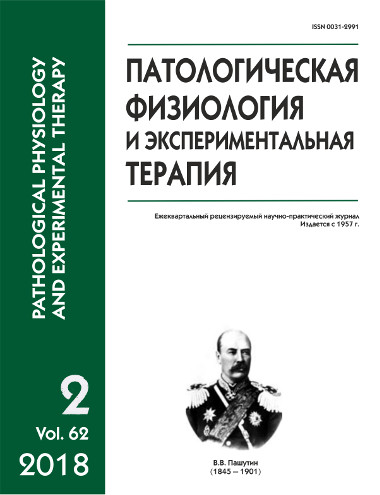Effect of melatonin on cellular composition of the liver in Wistar rats with alimentary obesity
Abstract
Aim. To identify and assess morpho-functional changes in the liver of Wistar rats on a model of alimentary obesity and correct the changes with the pineal hormone, melatonin, a universal adaptogen, immune modulator, and potent antioxidant. Methods. Sexually mature female Wistar rats aged 2 months and weighing 180–200 g at baseline were used for the experiment. Rats were allocated to three groups, 1) control group (intact rats); 2) group with alimentary obesity modeled by adding animal fat to the ad libitum standard laboratory diet for 3 months (obesity group); and 3) obesity group treated with melatonin 0.1 g/100 g body weight in 200 µl of distilled water, orally through a gastric tube, once daily for 14 days; during the treatment, animal fat was not excluded from the diet (obesity + melatonin group). Rats were sacrificed under etaminal anesthesia (40 mg/kg body weight) by decapitation. For morphometric and optical studies (LEICA DM 750 microscope, LEICA ICC 50 HD camera), histopathological preparations were fixed in 10% buffered formalin and examined with a standard method. Morphometric studies of liver samples were performed at a x1000 magnification on 5 µm sections stained with Mayer’s hematoxylin and eosin stain and Nile blue sulfate using superposition of point morphometric grids (grid of 256 points). Relative areas of sinusoid network, hepatocyte nuclei and cytoplasm; numerical density of sinusoidal cells, hepatocytes, and dual-parenchymal cells were measured. The nuclear-cytoplasmic ratio; ratio of sinusoidal cell numerical density to the numerical density of all hepatocytes; and per cent of diplocaryocytes of the total number of hepatocytes were computed; the Vizotto coefficient was calculated as a ratio of the area of sinusoid network to the area of all parenchymal hepatocytes. Results. Administration of the animal hormone, melatonin, exerted a pronounced effect on the studied morphometric parameters and reversed signs of circulatory and lymph flow disorders. Blood vessels of the portal area were preserved, and the architectonics of central veins was recovered. Most parts of hemo- and lymph circulation had no abnormal features. Conclusion. Obesity leads to significant disorders of blood circulation and lymph flow in the liver and results in fatty degeneration of hepatic parenchyma. Administration of the pineal hormone, melatonin, to such animals enhances reparative processes in the liver, normalizes microcirculation, and restores the structural and functional organization of the body.
Downloads
References
2. Beljakov N.A., V.I. Mazurov V.I. Obesity. [Ozhirenie]. Saint-Petersburg; SPbMAPO Publ.; 2003. (in Russian)
3. Vasendin D.V. Metabolic syndrome and structural and functional changes in the liver (scientific review). Profilakticheskaya i klinicheskaya meditsina. 2015; 3: 112 – 17. (in Russian)
4. Vasendin D.V. Modern approaches to the treatment of obesity (literature review). Uchenye zapiski Petrozavodskogo gosudarstvennogo universiteta. Seriya: Estestvennye i tekhnicheskie nauki. 2015; 151 (6): 72 – 80. (in Russian)
5. Arushanian E.B., Schetinin E.V. Melatonin as a universal modulator of any pathological processis. Pathological Physiology and Experimental Therapy. 2016; 60(1): 79-88. (in Russian)
6. Bespjatyh A.Ju., Burlakova O.V., Golichenkov B.A. Melatonin as an antioxidant: the main functions and properties. Uspekhi sovremennoy biologii. 2010; 130 (5): 487 – 96. (in Russian)
7. Syresina O.V., Zhukova E.A., Vidmanova T.A., Korkotashvili L.V., Kolesov S.A., Nefedova O.A. Melatonin in treatment of gastroesophageal reflux disease in children. Pediatricheskaya farmakologiya. 2012; 9 (1): 77 – 80. (in Russian)
8. Konenkov V.I., Klimontov V.V., Michurina S.V., Prudnikova M.A., Ishhenko I.Ju. Melatonin and diabetes: from pathophysiology to treatment perspectives. Sakharnyy diabet. 2013; 59(2): 11 – 6. (in Russian)
9. Avtandilov G.G. Medical morphometry. [Meditsinskaya morfometriya]. Moscow; Meditsina; 1990. (in Russian)
10. Vizotto L., Romani F., Fernario V.F. Characterization by morphometric of liver regeneration in the rat. The Amer. J Anatomy. 1989; 185: 444 – 54.
11. Lakin G.F. Biometrics. [Biometriya]. Moscow; Vysshaya shkola; 1990. (in Russian)
12. Michurina S.V., Vasendin D.V., Ishсhenko I.Ju. Liver morphological alterations in Wistar rats with alimentary obesity model. Vestnik Ivanovskoy meditsinskoy akademii. 2014; 19 (4): 19 – 22. (in Russian)
13. Butrova S.A., Eliseeva A.Yu. Non-alcoholic fatty liver disease: current projects. Ozhirenie i metabolizm. 2007; 1: 2 – 7. (in Russian)
14. Freneaux E., Larrey D., Pessayre D. Steatoses hepatiques medicamenteuses a triglycerides. Rev. Franc. Gastroenterol. 1988; 240 (24): 873 – 8.
15. Manne J., Argeson A.C., Siracusa L.D. Mechabisms for pleiotropic effects of the agouti gene. Proc. Natl. Acad. Sci. USA. 1995; 92: 4721 – 4.
16. Konenkov V.I., Borodin Ju.I., Ljubarskij M.S. Limphology. [Limfologiya]. Novosibirsk; Izdatel'skiy dom "Manuskript"; 2012. (in Russian)
17. Luk'janova L.D. Bioenergetic hypoxia: definition, mechanisms, and methods of correction. Bulleten' eksperimental'noy biologii i meditsiny. 1997; 124 (9): 244 – 54. (in Russian)
18. Shul'pekova Yu.O. The pathogenic role of lipids in nonalcoholic fatty liver disease. Rossiyskiy zhurnal gastroehnterologii, gepatologii, koloproktologii. 2012; 22 (1): 45 – 56. (in Russian)
19. Berezovskij V.A., Yanko R.V., Litovka I.G., Volovich O.I. Reactivity of the liver parenchyma of rats after administration of exogenous melatonin. Ukrainskiy morfologicheskiy al'manakh. 2012; 4: 178 – 81. (in Russian)
20. Arushanyan EH.B. Limiting oxidative stress as the main reason for the universal protective properties of melatonin. Ehksperimental'naya i klinicheskaya farmakologiya. 2012; 75 (5): 44 – 9. (in Russian)
21. Kozirog M., Poliwczak A.R.P., Duchnowicz P., Koter-Micholak M., Sikora J., Broncel M. Melatonin treatment improves blood pressure, lipid profile and parameters of oxidative stress in patient with metabolic syndrome. J. Pineal Res. 2011; 50: 261 – 6.






